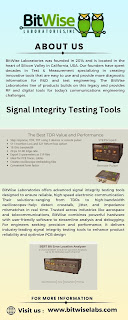Test Insertion Loss Measurement
Test insertion loss refers to the
reduction in signal strength that occurs when a device or component is inserted
into a transmission line or network. This loss is quantified in decibels and is
a critical parameter in evaluating the performance of various electronic
components, such as connectors, cables, filters, and amplifiers. Essentially,
insertion loss measures how much of the signal is "lost" or
attenuated as it passes through the device under test.
In the realm of electronic testing
and telecommunications, one crucial parameter that engineers and technicians
frequently encounter is "test insertion loss." This metric plays a
significant role in assessing the quality and performance of various electronic
components, particularly in signal transmission systems. At Bitwise
Laboratories, we focus on providing comprehensive insights and precise
measurements related to insertion loss, helping our clients optimize their
electronic systems and ensure optimal performance.
Insertion loss is a key
consideration in many applications, including telecommunications, data
communications, and broadcasting. It affects the overall signal quality and
system performance, making it essential for engineers to accurately measure and
understand this parameter.
Importance
of Measuring Insertion Loss
Accurate measurement of insertion
loss is crucial for several reasons:
- Signal Integrity:
High insertion loss can lead to degraded signal quality, which may result
in poor performance or complete signal failure. By measuring insertion
loss, engineers can identify potential issues and take corrective actions
to maintain signal integrity.
- System Performance:
Insertion loss impacts the overall performance of electronic systems. In
telecommunications, for example, excessive insertion loss can lead to
reduced data transmission rates and increased error rates. Accurate
measurements help in designing and optimizing systems for better
performance.
- Component Testing:
For manufacturers and designers, testing the insertion loss of components
is essential to ensure that they meet specified performance standards.
This is particularly important for components used in high-frequency
applications, where even small losses can have significant impacts.
- Quality Assurance:
Regular testing and measurement of insertion loss are integral to quality
assurance processes. It ensures that components and systems function as
expected and adhere to industry standards and specifications.
How
Bitwise Laboratories Measures Insertion Loss
At Bitwise Laboratories, we utilize
state-of-the-art equipment and methodologies to accurately measure insertion
loss. Our approach involves the following key steps:
- Setup and Calibration:
We begin by setting up the test environment and calibrating our equipment
to ensure accurate measurements. Calibration is crucial to minimize errors
and ensure that the results reflect the true performance of the DUT.
- Test Procedure:
The DUT is connected to a network analyzer or a similar testing device.
The network analyzer sends a signal through the DUT and measures the
output signal strength. By comparing the input and output signal
strengths, we can determine the insertion loss.
- Data Analysis:
The measured data is analyzed to calculate the insertion loss in decibels.
We also evaluate the results to identify any deviations from expected
performance and assess the overall quality of the component or system.
- Reporting:
We provide detailed reports that include the measured insertion loss
values, along with any relevant observations and recommendations. Our
reports help clients understand the performance of their components and
make informed decisions.
Unique
Aspects of Our Approach
At Bitwise Laboratories, we pride
ourselves on our unique approach to measuring and analyzing test insertion
loss. Here are a few aspects that set us apart:
- Precision Equipment:
We use advanced and highly accurate testing equipment to ensure precise
measurements. Our network analyzers and other testing tools are regularly
calibrated and maintained to deliver reliable results.
- Expert Analysis:
Our team of experienced engineers and technicians brings a wealth of
knowledge and expertise to the analysis process. We not only measure
insertion loss but also provide insightful analysis to help clients
understand the implications of the results.
- Customized Solutions:
We understand that each client's needs are unique. Therefore, we offer
customized testing solutions tailored to specific requirements. Whether
it's for high-frequency applications or complex systems, we provide
solutions that address individual challenges.
- Comprehensive Reporting: Our detailed reports include not only the measured
values but also an interpretation of the results and recommendations for
improvement. This comprehensive approach helps clients make informed
decisions and enhance their system performance.
Its
Benefits
The accurate measurement of
insertion loss has numerous applications and benefits across various
industries:
- Telecommunications:
Ensures that signal quality remains high, minimizing data loss and
communication errors.
- Data Centers:
Helps in optimizing network performance and reliability by identifying and
addressing potential issues.
- Broadcasting:
Ensures high-quality signal transmission for television and radio
broadcasting.
- Consumer Electronics:
Improves the performance and reliability of electronic devices such as
smartphones, televisions, and audio equipment.
Conclusion
Test insertion loss is a critical parameter in electronic testing, and accurate
measurement is essential for ensuring optimal performance and quality. At
Bitwise Laboratories, our commitment to precision and expertise in measuring
insertion loss helps our clients achieve their performance goals and maintain
high standards in their electronic systems. By understanding and addressing
insertion loss, we contribute to the advancement and reliability of technology
across various applications.
Visit us: https://bitwiselabs.com/




Comments
Post a Comment